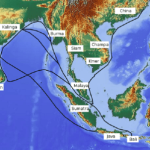Europe and Asia
At the zenith of the Roman Empire, overland trade joined the cultures of Europe, North Africa, Asia Minor, China, and India. But the system of road transport was dependent on the Roman, Chinese, and Mauryan empires, and, as these great empires declined in the early Christian era, the trade routes became routes of invasion. Except in the Byzantine Empire, road networks fell into centuries of disrepair. Transport relied on pack trains, which could negotiate the badly maintained roads and sufficed to carry the reduced stream of commerce.
The first signs of a road revival came during the reign of Charlemagne late in the 8th century. In the 9th century the Moors established an extensive street network in Córdoba, Spain. The Vikings operated the Varangian Road, a major trade route linking the Baltic and the Middle East via Russia. Further road revival was aided first by the need to service the regular round of trade fairs and then, in the 11th century, by a centralization of power and an increase in religious fervour.
Eventually a commercial revival set in. By the 12th century old cities were reviving and new ones were being built, especially in western Europe. Street paving became a reputable artisan activity, and by the 15th century well-maintained roads bringing food to the cities from their hinterlands were of critical importance. At the same time, wheeled vehicles increased in number and quality. There was an awakened interest in better overland travel, better protection of merchants and other travelers, and the improvement of roads. Public funds, chiefly derived from tolls, were committed to road upkeep. The corvée, or road-labour tax, made an even more substantial contribution. Long-distance overland commerce increased rapidly and included a restoration of the trade route between Europe and China through Central Asia that Marco Polo traveled in the late 13th century.
Inca roads of South America
Across the Atlantic, the period witnessed the rise of another notable road-building empire, that of the Incas. The Inca road system extended from Quito, Ecuador, through Cuzco, Peru, and as far south as Santiago, Chile. It included two parallel roadways, one along the coast about 2,250 miles in length, the other following the Andes about 3,400 miles in length with a number of cross connections. At its zenith, when the Spaniards arrived early in the 16th century, a network of some 14,000 miles of road served an area of about 750,000 square miles (1,940,000 square kilometres) in which lived nearly 10 million people. The network was praised by 16th-century explorers as superior to that in contemporary Europe.
The Andes route was remarkable. The roadway was 25 feet wide and traversed the loftiest ranges. It included galleries cut into solid rock and retaining walls built up for hundreds of feet to support the roadway. Ravines and chasms were filled with solid masonry, suspension bridges with wool or fibre cables crossed the wider mountain streams, and stone surfacing was used in difficult areas. The steeper gradients were surmounted by steps cut in the rocks. Traffic consisted entirely of pack animals (llamas) and people on foot; the Inca lacked the wheel. Yet they operated a swift foot courier system and a visual signaling system along the roadway from watchtower to watchtower.



Comments are closed